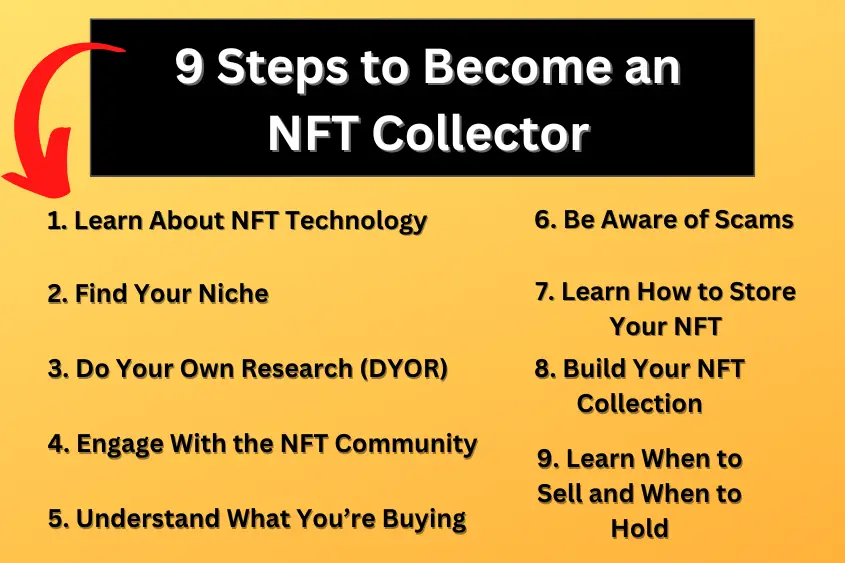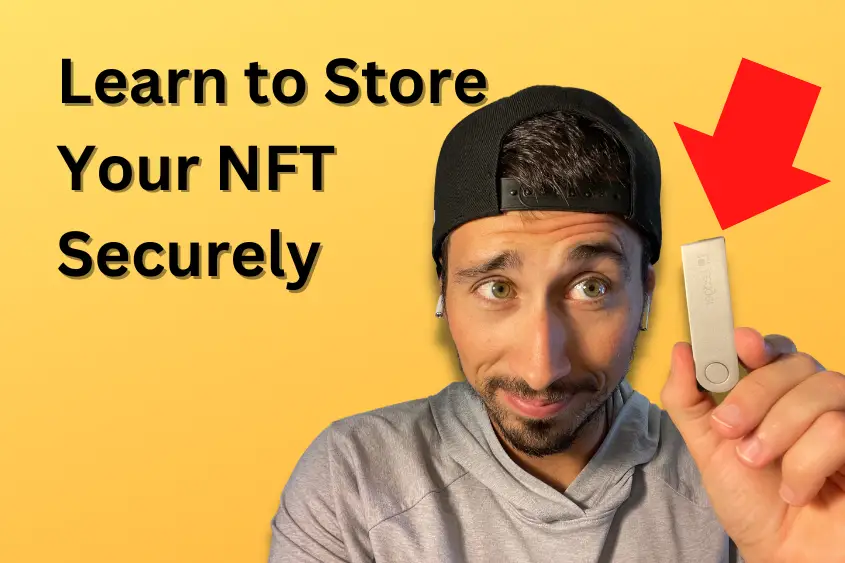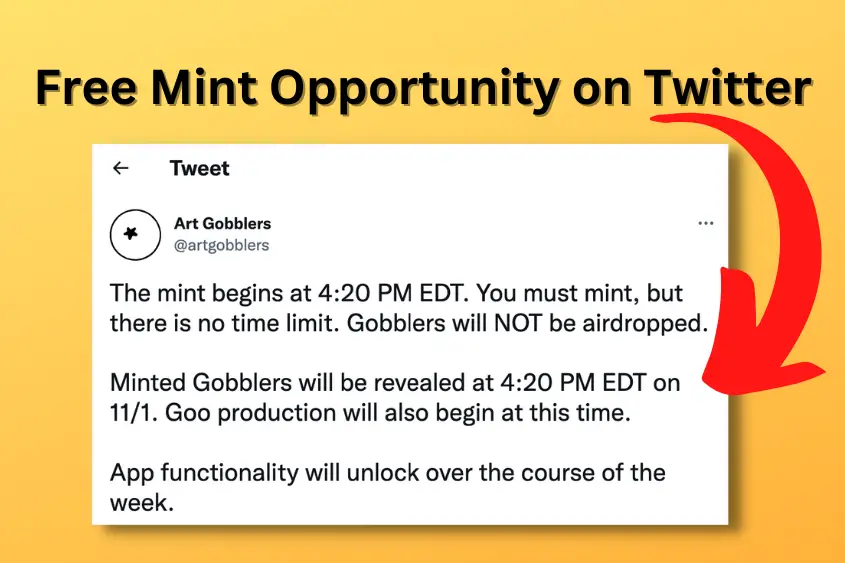NFTs have quickly become the talk of the collectibles world. Influencers like Gary Vee and Snoop Dogg have spent millions of dollars collecting these digital assets, and others have become millionaires by becoming NFT collectors. So, how can you become an NFT collector?
Below, I walk you through nine steps that will provide you with a solid foundation to get started collecting NFTs.
How to Become an NFT Collector

1. Learn About NFT Technology
Before you can begin collecting NFTs, you need to learn about the underlying technology including what an NFT is. In short, an NFT is a digital asset that is stored on a decentralized public ledger called the blockchain.
The blockchain is an immutable record, meaning it can’t be changed, and it can be viewed by anyone. An NFT’s data is stored on the blockchain which gives it the ability to be owned since anyone can verify whose wallet the asset is stored in.
Furthermore, an NFT isn’t simply an image on your screen. Smart contract technology enables NFTs to store additional perks, hence providing more value to the holders.
For example, an NFT’s smart contract could give you access to an exclusive event like a concert or conference.
Beyond its smart contract technology, NFTs remain a proof of record. Therefore, we can assume that brands which started as NFTs such as Bored Ape Yacht Club and VeeFriends, might be valuable in the future as the brand continues to grow.
Similar to how original sketches of the iconic Mickey Mouse have sold for thousands to millions of dollars, certain NFTs that mark the beginning of legendary brands could be worth big bucks in the future.
2. Find Your Niche
Every collector has a niche or even multiple niches they enjoy dabbling in. Sports cards, sneakers, and stamps are all examples of collectible niches. Also, most niches have sub-niches.
Do you like MLB or NBA sports cards? Do you collect Jordans or Nikes? Perhaps you enjoy the over-arching niche and collect everything that falls under it.
Regardless, you have to find a niche before you can start collecting NFTs.
Generally, your niche is something you’re genuinely interested in and have some knowledge of.
Or, you might find a new niche that has sparked your interest. In that case, you will have to put in the time to educate yourself about the topic if you’re trying to build a solid collection.
Just like IRL collectibles, the digital collectibles space has plenty of niches to choose from. Many of which are in the same realm as popular physical collectibles.
Below are some examples of popular niches NFT collectors have taken a liking to.
- Art
- Profile Pic Projects (PFP)
- Historical NFTs
- Intellectual Property
- Sports Cards
- In-Game Characters
That said, as the NFT space continues to expand more industries are beginning to bring their brands into the space. As a result, we will continue to see a wider array of digital collectibles.
That’s one reason why being knowledgeable about your niche gives you a huge advantage; you’ll know when brands are making moves so that you can jump on board early.
3. Do Your Own Research (DYOR)
No matter how knowledgeable you might think you are on a certain niche or brand, always do your own research before investing money into a digital collectible.
Many brands are entering the web3 space as we speak, but not all of them will be successful.
Gary Vee recommends a minimum of “50 hours of homework” before pulling the trigger on an NFT.
So, how do you research an NFT? Here are some actionable steps you can take to DYOR.
- Follow the brand on social media and observe its engagement. A brand that engages with its community tends to understand its community better. As well, you can get a better feel for the brand by observing its interactions.
- Get involved in the community. Wherever the brand lives you should be there too. Twitter, Discord, YouTube, and Instagram are all places where brands are built today. Ask questions, make friends, and get involved.
- Observe what others are saying. Following a brand on social media is like having a front-row seat to the review section of a company. What are other people saying about the brand? Is it mainly positive or negative? Perception matters.
These steps won’t guarantee that you find the best NFT to collect, however, they can help you determine if a brand is worth pursuing further.
4. Engage With the NFT Community
In the macro, the NFT community is the entire online community of people who live and breathe the technology on a daily basis.
Engaging with others who share these interests will help you learn more about the technology which can lead you to better decisions when collecting.
Beyond the macro community lives micro-communities. These communities are brand-specific communities that include big-name brands and personal brands and creators.
Micro-communities are where you go when you’re looking to learn more about a brand before deciding to buy into their collectibles.
Both macro and micro-communities are crucial to your overall success as an NFT collector, as they both provide you with the info you need to make the best buying decisions.
So, where can you find these communities? Online.
Twitter, Discord, YouTube, and forums like Reddit are where you can find the NFT community hanging out.
5. Understand What You’re Buying
Before you buy an NFT, make sure you know what you’re buying. Some NFTs really are just an image. And some of those images go for big money because they’re scarce pieces of art created by popular artists.
But, just because something is scarce doesn’t make it rare or valuable. The artist makes art valuable, not the other way around.
Some NFTs might include other perks that make them valuable such as access to an event or community, or a physical product, among other things.
It’s up to you to determine if you find value in what is being offered through an NFT.
Just remember, items (including digital goods) are considered collectibles due to their rarity, popularity, and condition.
Arguably, rarity and popularity are the two main factors in determining a good digital collectible considering condition isn’t as relevant in the digital space.
6. Be Aware of Scams
Unfortunately, scams are a big part of the collectibles space, and even more so when it comes to NFTs. Knowing the top NFT scams to avoid will help you stay safe when trying to find the next best NFT to collect.
Here are some of my top tips to avoid being scammed in the NFT space.
- Never give out your secret phrase
- Avoid visiting untrustworthy sites
- Always do your own research
- Watch out for rug pulls
- Don’t get greedy
- Only transact with people you trust
- Be aware of counterfeit NFTs
- Steer clear of brand impersonators
Luckily, I have only been scammed once since I started collecting NFTs. And the reason I have been able to steer clear of so many scams is that I’ve known what to watch for.
So please, be cautious and always verify what you are buying is authentic and from a legit source. This goes back to doing your own research.
7. Learn How to Store Your NFT Collection Properly

Learning how to properly store your NFT collection is one of the most important aspects of becoming an NFT collector. If you fail to store your NFTs securely, then you risk losing your entire collection.
To store your NFT collection you’ll want to use an NFT hardware wallet. A hardware wallet is more secure than popular software wallets like MetaMask since it stores all of your private data offline including your secret phrase and PIN code.
Most NFT collectors are hacked through their wallets. The simple act of connecting your wallet to a malicious site can result in your wallet being drained entirely; it happens every day.
So what’s the solution?
Storing your NFTs in a hardware wallet will keep your collectibles safe. And using a second wallet (not the one you use for storage) for your purchases allows you to buy NFTs with reduced risk.
Sure, you can still be scammed. But at least all of your NFTs won’t be stolen if you are scammed.
8. Build Your NFT Collection
After learning all there is to know about NFTs including how to find good ones, how to buy NFTs, how to avoid scams, and how to store them safely, you are well on your way to becoming an NFT collector.
Now it’s time to use what you learned to start buying and collecting NFTs. There’s just one more thing though.
Never spend more money than you can afford to lose.
Believe me when I say it’s not worth buying an NFT if that means you can’t afford to pay your rent.
Having said that, if you have extra funds you might want to look into blue chip NFTs. These NFTs are generally well-known, established, somewhat stable, and considered to be a good long-term investment.
If you don’t have the funds to invest in blue chip NFTs, then your best bet is to collect NFTs you thoroughly enjoy or find up-and-coming artists and brands that haven’t yet gained recognition.
9. Learn When to Sell and When to Hold
If your goal is to make money as an NFT collector, then you need to know when to sell and when to hold. If you plan to sell your collectible NFTs, you want to sell at the height of the market.
To determine if the market is doing well, you can check historical floor price and transaction volume data using a tool or on a marketplace like Opensea.
If you find that your NFT is valued high, especially if it’s worth more than what you paid for it, then it may be a good time to sell.
Likewise, if you discover that your NFT is at an all-time low or is valued less than what you paid for it, it’s probably not a good time to sell.
The hardest thing about knowing when to sell and when to hold is that the NFT collectible market is so volatile. Also, it’s still in its infancy.
Hence, there’s no telling how much something is going to be worth 1, 5, 10, or even 40 years from now.
Perhaps if you do your research and make the right moves you might be able to gather a nice collection and profit nicely in the future.
Can I Become an NFT Collector With No Money?

You can become an NFT collector with very little money by finding and partaking in free mints and giveaways. However, you may still have to pay a transaction fee which ranges from $5 to over $100. You can then sell your NFT for a profit and reinvest it to further grow your collection.
Let’s take a look at the various ways you can collect NFTs with little or no money.
Free Mints
A free mint allows you to mint an NFT for free. The only fee you might have to pay is the transaction fee. Depending on which blockchain the NFT is minted on, this fee can range anywhere from a couple of dollars to over a hundred dollars.
So, how do you participate in a free mint? First, you have to find a project that hasn’t launched yet.
Again, social media is your best option for finding NFT projects that are about to launch.
Twitter is a great place to start. And some YouTube channels even provide alpha that will tell you about upcoming NFT drops.
Once you find a project, make sure to follow it on all of its social media channels and turn your notifications on.
Also, if the project has a Discord group, make sure to join it and get active in the chat.
Generally, free mints will be provided to those who are either extremely active in the community or to those who have helped the project in some way.
Sharing social media posts and inviting your friends to join the community is legitimate ways you can help an NFT project grow. And if you’re lucky, you might be rewarded with a free mint.
Giveaways
An NFT giveaway is a marketing tactic used by the projects to foster engagement and drive hype to the brand. To win a giveaway, a project might require you to share their posts on social, invite your friends, or simply enter a randomized drawing. Giveaways are usually completely free.
Similarly to free mints, you’ll want to follow the project on all social platforms and engage with the community.
This can increase your odds of being considered for the giveaway.
Examples of Free NFTs
I know what you might be thinking. How much can a free NFT really be worth? Well, history shows it can be worth a lot of money.
Here are some examples of free NFTs that were worth big money.
Mutant Ape Yacht Club Serum
Mutant Ape Yacht Club (MAYC) is the sequel to Bored Ape Yacht Club (BAYC). Although not all Mutant Apes were available for free, all BAYC holders were airdropped free Serum NFTs that could be used to transform their Apes into Mutant Apes.
These Serums were selling for absurd amounts, with the most expansive sale ticking in at $5.8 million. To be fair, you had to of already owned a BAYC NFT to receive the Serum. Nonetheless, it was a free NFT that sold for a lot of money.
Goblintown
Goblintown NFT was a completely free mint of 10,000 NFTs, with the exception of gas fees. At the time of mint, collectors were selling these NFTs for 6 ETH ($11,500 at the time) and they paid virtually nothing to receive the NFT.
Art Gobblers
Art Gobblers is an NFT collection created by Rick and Morty co-creator Justin Roiland. Despite the controversy surrounding Justin, the first 2,000 NFTs from this collection were all minted for free almost instantly.
In fact, in the first 12 hours after release, Art Gobblers did over 7,000 ETH (about $11 million) in sales volume on the secondary market.
And the collectors who minted this NFT were selling it for 13 ETH to 18 ETH ($20,000 to $28,000).
Now, imagine taking those profits and investing them into building your dream NFT collection. That’s how you can become an NFT collector with no money.

3 thoughts on “How to Become an NFT Collector (In 9 Simple Steps)”
Comments are closed.